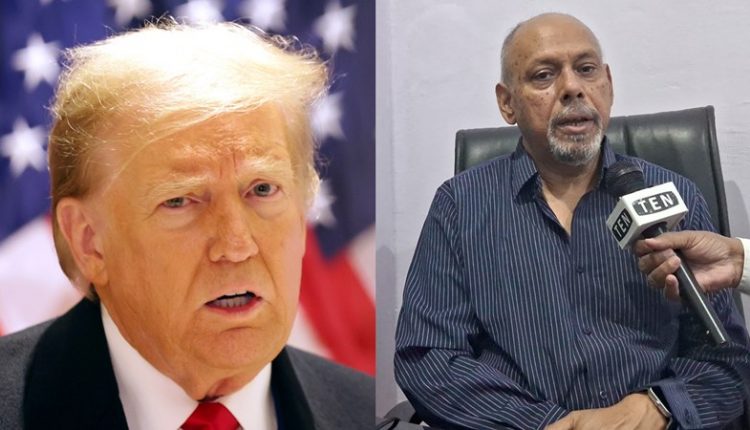Trump’s Tariff War and Its Impact on India: Insights from Geopolitical Analyst Indranil Banerjie
TEN NEWS NETWORK
Greater Noida (3 June 2025): The ongoing ripple effects of Donald Trump’s tariff-driven trade strategies have stirred intense global debate, particularly regarding their implications for emerging economies like India. In an exclusive conversation with TEN News Network, renowned geopolitical analyst Indranil Banerjie offers a compelling analysis of Trump’s economic maneuvers — framing them not merely as protectionist policies, but as calculated tools of geopolitical leverage. Banerjie sheds light on the multifaceted nature of Trump’s tariff war, highlighting its consequences for India’s export sectors, student visa policies, and broader strategic positioning in a rapidly evolving global order.
Tariffs, Trade, or War? A Multi-Pronged Strategy
When asked whether Trump’s aggressive economic measures could be characterized as a “war,” that it’s a mix of all — a trade war, a tariff war, and a geopolitical maneuver. According to him, Trump’s primary objective is not necessarily to implement lasting high tariffs but to use them as leverage in international negotiations.
Trump isn’t looking to permanently impose unsustainable tariffs of 50% or 100%, Banerjie explained. Such moves would ultimately harm American consumers and the U.S. economy itself. His intent seems to be coercive diplomacy — using tariffs as tools to pressure other countries into offering trade concessions.
Banerjie emphasized that Trump’s strategy is based on economic nationalism. Countries that comply and negotiate, such as India, may avoid harsh penalties, while others like China, which resist American demands, face more severe consequences.
Impact on India’s Export Landscape
India, with its growing export economy, could be vulnerable to shifts in U.S. trade policy. Trump’s emphasis on “America First” and promoting U.S.-made products over foreign imports poses challenges for countries like India.
However, Banerjie believes that India might not fare as badly as some might assume. While certain sectors — like steel — could face targeted tariffs, India’s diversified trade relations and ongoing negotiations with the U.S. may help cushion the blow.
India may actually benefit in some areas, he said. Trump is not aiming to eliminate all imports — he’s focused on strategic manufacturing like semiconductors, automobiles, aerospace components, and electronics. He wants to bring back critical industries, not low-end manufacturing like textiles or socks.
According to Banerjie, India’s steel exports might face pressure, especially with rising tariffs being imposed by the U.S. But compared to nations with heavier reliance on strategic exports, India’s relative position could remain stable — or even improve in specific sectors.
Student Visa Crackdowns: A Growing Concern
One area where Banerjie expressed concern was Trump’s stance on student visas. He noted that recent years have seen increasing restrictions on international students, especially those from India. Trump’s policies, he said, are driven by a desire to prioritize American citizens for education and employment opportunities.
This is definitely a problem for Indian students, Banerjie remarked. Trump’s voter base supports stricter immigration rules. The U.S. no longer wants the inflow of foreign students who often stay back, get jobs, and eventually bring their families over. That era is being rolled back.
He added that this shift could have long-term implications for Indian students aspiring to study and work in the U.S., particularly in STEM fields where Indians have traditionally excelled.
The Bigger Picture: America’s Global Positioning
Banerjie also addressed a broader geopolitical theme. He asserted that the U.S., under Trump’s leadership, is determined to retain its position as the global superpower — whether through economic tariffs, military strength, or political influence. America doesn’t want to be number two, Banerjie said. They’re using every tool at their disposal — tariffs, sanctions, strategic alliances — to maintain their global dominance.
A Hope for Balance
Despite the challenges, Banerjie concluded with a note of cautious optimism. He expressed hope that the current tariff regime would ease over time, allowing for more equitable global trade. Affordable, quality products manufactured across various nations should not be stifled by excessive protectionism, he said ,For the sake of humanity and economic fairness, we hope these tariffs are reduced. Countries should be able to produce quality goods at competitive prices without being punished.
Background: Trump’s Tariff Strategy
Trump’s trade war began during his first term in office, with heavy tariffs imposed on China in response to alleged unfair trade practices and intellectual property theft. His administration gradually expanded this approach to include allies and partners, including the EU, Canada, and India, often using tariffs as a negotiation tactic.
The aim was to reshape global supply chains to favor American workers and manufacturers, reduce trade deficits, and bring back high-value industries to the U.S. However, critics argue that the tariffs have led to inflation, retaliatory measures, and disruption in global trade.
As the global economic order continues to adjust to shifting power dynamics, India must remain vigilant, strategic, and responsive. While Trump’s policies present challenges, they also open doors for renegotiation, innovation, and a reevaluation of India’s position in the global value chain.
Dear Readers and Viewers, Ten News Team daily publishing / curating latest and top ten news, from ten news categories. So please keep visiting tennews.in : National News Portal thrice a day and subscribe it by submitting e mail at home page.
Also keep watching TEN NEWS NATIONAL YouTube Channel and subscribe it to watch Delhi / National News Videos.



Comments are closed.